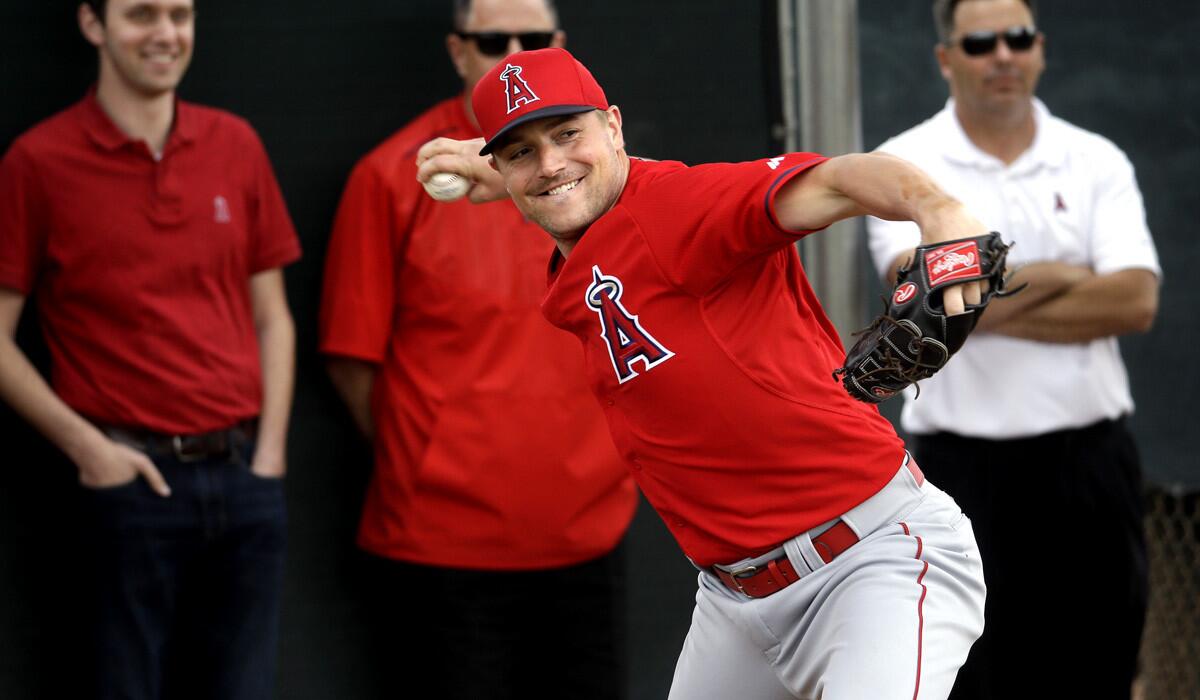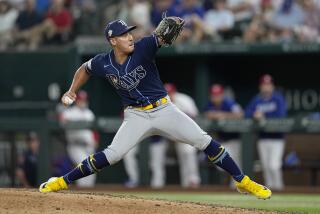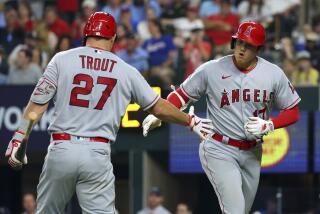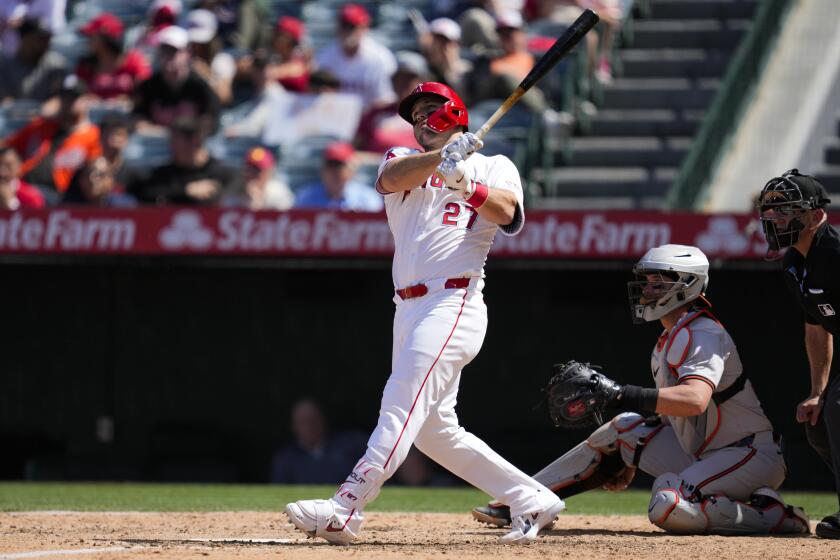Angels’ Joe Smith and Huston Street are artful relievers

Angels sidearm reliever Joe Smith throws during a spring training workout.
They’re slingshot-wielding relievers in a game of flame throwers, two stick-and-move artists among punch-out specialists.
Angels closer Huston Street and setup man Joe Smith won’t wow you with stuff. Street mixes a 90-mph fastball with a slider and changeup; the sidearm-throwing Smith relies on an 89-mph fastball and slider.
They’re not fueled by high-octane gas like the Kansas City bullpen, which features the blazing fastballs of Kelvin Herrera (98 mph), Wade Davis (96 mph) and Greg Holland (96).
But Street and Smith worked wonders for the Angels last season, solidifying a shaky bullpen and keying the team’s run to the American League West title. The Angels will lean heavily on the duo again this year.
“We’ve had really hard throwers, but I don’t think any of us ever felt more comfortable than we did last year having two guys in the back of the bullpen throwing 88 mph,” General Manager Jerry Dipoto said.
“They don’t have the gaudy 98-mph fastball or the wicked Clayton Kershaw curveball. But they have the know-how, the command and the ability to manipulate the ball. They have multiple pitches, deception and a general calm with which they go about their job.”
Smith signed a three-year, $15.75-million deal before last season, then finished 7-2 with a 1.81 earned-run average and 15 saves, striking out 68 and walking 15 in 74 2/3 innings. He did not give up a run in 67 of 76 appearances.
Street, acquired from San Diego in July, was 1-2 with a 1.71 ERA and 17 saves in 28 games with the Angels, striking out 23 and walking seven in 26 1/3 innings.
They were nowhere near as dominant as the Royals trio, which combined for a 1.28 ERA and 258 strikeouts in 204 1/3 innings. But in their way, they were nearly as effective.
“We definitely don’t fit the mold of guys who throw 95-100 mph with wipeout sliders,” Smith said. “But we throw strikes, we keep the ball in the park and pitch down in the zone. When you do that, you give up singles instead of homers and doubles off the wall. It takes a few more hits to beat you.
“For me, three outs is three outs. If you punch three guys out, that’s great, but you probably used 22 pitches. I got three outs and used eight pitches. I can throw the next day and be completely fine.”
Street and Smith had never met before last summer, but they quickly developed a bond, and not just because they have similar, easy-going personalities, blue-collar work ethics and refuse to make excuses.
Smith, 30, replaced the struggling Ernesto Frieri as closer in late June and converted his first 10 save opportunities, giving up no runs and two hits in 11 1/3 innings.
When the Angels traded for Street, Smith graciously yielded the closer job to the 31-year-old who has converted 97 of 103 save opportunities since 2012, a major league-best 94.2% conversion rate.
“He was absolutely in a position to say he deserves to keep the role,” Street said. “But at the same time, we both want what’s best for the team. I was welcomed with open arms, and Joe was very much the leader in that.”
Street has racked up 275 saves in 10 years while relying on pinpoint command of his three pitches, getting ahead in counts, an innate feel for hitters and an ability to make pitch-to-pitch adjustments.
“We pay attention to what hitters do, we’re always making that next pitch off the pitch we just threw,” Street said. “‘Did he lean out on that fastball away? When I threw the slider, did he kind of buckle on it?’
“”I’ve always had that ability to kind of feel the game, but I’ve also crafted my game to try to get certain types of outs.”
Street blew only two saves for the Angels last season, and he threw three hitless innings in the first two games of the division series against Kansas City. But his most memorable game came Aug. 1, after he allowed Tampa Bay to load the bases with no outs in the ninth.
Street struck out Desmond Jennings and Ben Zobrist, getting both to chase sliders, and got Matt Joyce to fly to center field, preserving a 5-3 victory.
“He knows how to get you out without exposing too much of the baseball to the plate,” Dipoto said. “I think that really separates him.”
Smith relies most heavily on the movement and feel of a fastball that either runs in on the hands of or sinks away from a right-handed hitter.
“Some days it sinks more than runs. Some days it runs more than sinks. You have to make adjustments,” Smith said. “You have to figure out real quick what your stuff is doing, and sometimes I don’t know until get on the mound.”
Smith’s deception comes with odd angles and arm slots. Street’s comes with a release point that is the same on all three pitches, making it difficult for hitters to pick him up.
“I don’t care if you throw 98 or 87 or 84, the one common denominator between any reliever or pitcher who lasts in baseball is deception, hiding the baseball,” Street said. “Guys like [Greg] Kimbrel, [Aroldis] Chapman and Holland have both, cartoon stuff and great deception, and that’s where you get the stupid numbers.
“But there’s no category that can explain deception other than results. Great stuff makes it easier to get away with mistakes. But how many guys with stuff do you see get knocked all over the yard? The reason? They don’t have deception. And you can’t teach it. It’s either there or not.”
More to Read
Go beyond the scoreboard
Get the latest on L.A.'s teams in the daily Sports Report newsletter.
You may occasionally receive promotional content from the Los Angeles Times.







